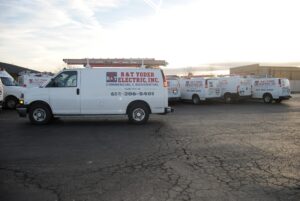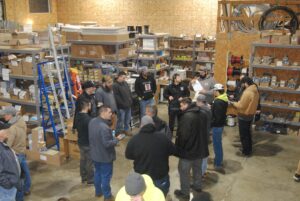
When we plug in something — whether an appliance, phone charger, or game console — we usually don’t give much consideration to how it works. Most homeowners simply know that they receive power from their various home outlets without giving a second thought to the brains of their homes. We’re talking about the four types of electrical panels: the main breaker box, the alternative fuse boxes, lug panels, and subpanels.
The main breaker panel
The main breaker panel is what most homeowners think of when they think of their home’s electrical panel. This is a rectangular box, usually of a dark gray color, that acts as the main brain of your house. Home appliances are wired to specific circuits based on their power demands, with larger fixtures such as your stove and furnace wired to their own circuits.
When there is too much power flowing through the circuit, the breaker “trips” which stops the electricity for anything on it. You have to manually reset the breaker to restore power to the attached systems.
An alternative: fuse boxes
How old is your home? If it’s relatively older, it may still have a dated type of electrical panel called a fuse box. When the circuit trips, the fuse will blow to cut the power. To restore the flow of electricity, you will need a new fuse for that circuit.
Subpanels
Do you have a detached garage? How about a pool, hot tub, spa, or a powered shed in your backyard? If you answered yes to any of these, then it’s likely your home has some kind of subpanel setup.
Subpanels tie into your existing primary breaker box. They can be in your basement, such as in the case of a pool or spa. Alternatively, a secondary structure such as a powered shed or a detached garage will often have the subpanel in it with the necessary wires trenched and backfilled. Then, those cables connect to your primary electrical panel in your basement.
Lug panels
Within the category of subpanels is another category of an electrical box: lug panels. In function, these are similar to subpanels: they act as a way of controlling the power to secondary areas of your home.
The primary difference between lugs and subpanels is that lug panels do not have a primary breaker to kill the power to the attached system. A subpanel will have a way of stopping the electric flow via a primary kill switch.
Which of the four types of electrical panels do you have?
And better yet, when was the last time you updated or replaced them? If you’re still running fuse boxes in your home, it’s time to upgrade to a newer electrical panel. And if
your electrical panel is over 15 years old, it may be time to consider working with a residential electrician such as R&T Yoder Electric.
Our expert team members can look at your home’s power needs, identify any weak spots, help install or update new panels, and ensure that you have the electricity you need. We also specialize in helping industrial and commercial facilities with these same types of requests.
Whichever category of consumer you’re in, remember we’re here to help. Contact us today to schedule your appointment with a Yoder Electric professional or call our sales department at (614) 992-7856.










